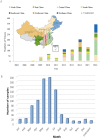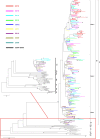The emerging sub-genotype C2 of CoxsackievirusA10 Associated with Hand, Foot and Mouth Disease extensively circulating in mainland of China
- PMID: 30190558
- PMCID: PMC6127217
- DOI: 10.1038/s41598-018-31616-x
The emerging sub-genotype C2 of CoxsackievirusA10 Associated with Hand, Foot and Mouth Disease extensively circulating in mainland of China
Abstract
Coxsackievirus A10 (CV-A10) associated with Hand, foot, and mouth disease (HFMD) cases emerged increasingly in recent years. In this study, the samples from nation-wide HFMD surveillance, including 27 out of 31 provinces in China were investigated, and the continuous and extensive virological surveillance, covered 13 years, were conducted to provide a comprehensive molecular characterization analysis of CV-A10. 855 CV-A10 viruses (33 severe cases included), were isolated from HFMD children patients during 2009 to 2016 in China. 164 representative sequences from these viruses, together with 117 CV-A10 sequences downloaded from GenBank based on entire VP1 were recruited in this study. Two new genotypes (F and G) and two sub-genotypes (C1 and C2) were identified. Among 264 Chinese sequences, 9 of them were genotype B, 8 of them were C1, and the other (247) were C2, the predominant sub-genotype in China since 2012. Chinese C2 viruses showed obvious temporal characteristics and can be divided into 3 clusters (cluster 1~3). Cluster 3 viruses was circulating extensively during 2014 and 2016 with more severe cases. It is very necessary and important to continuously conduct the extensive virological surveillance for CV-A10, and further evolutionary studies will provide more evidence on its evolution and virulence.
Conflict of interest statement
The authors declare no competing interests.
Figures




References
Publication types
MeSH terms
LinkOut - more resources
Full Text Sources
Other Literature Sources
Miscellaneous

